Irrigation Techniques For Florida Peaches
Irrigating to optimize water use and reduce nutrient leaching is one of the main concerns for tree fruit growers in the U.S., and Florida is no exception. Increasing demand in urban areas for water and food supplies, as well as increasing specialty crop production, stretch available water resources.
 Growers also must comply with the Clean Water Act, set forth by the EPA. Minimizing water pollution due to nutrient leaching (predominantly from fertilizers), requires proper irrigation application to avoid conditions that lead to nutrient leaching.
Growers also must comply with the Clean Water Act, set forth by the EPA. Minimizing water pollution due to nutrient leaching (predominantly from fertilizers), requires proper irrigation application to avoid conditions that lead to nutrient leaching.
The impact of citrus greening in Florida has led to increased farm diversification, and the success of Florida peaches in the marketplace have growers interested in peach production. However, many production techniques cannot be simply translated to from citrus to peaches, particularly irrigation applications.
Research on irrigation requirements for subtropical peach production is limited. Although peach irrigation research has been conducted in other U.S. locations, they should not be extrapolated for use in Florida because of the different soil and climate conditions, particularly our Flatwood soils with limited drainage, and the subtropical climate.
In Florida, since the majority of peach growers have experience in citrus production, it has been a simple shift to use irrigation techniques, rates and volumes typically used in citrus for peaches. However, peaches are deciduous and its requirements are different from evergreen trees like citrus. We have limited experience in subtropical peach production to know if we are delivering the right amount of water to the tree.
Fruit trees that undergo drought periods will exhibit reduced plant growth, fruit size and in severe cases, reduced total yield. The perennial nature of trees leads to preservation of the structure over preservation of the fruit and seed; thus proper irrigation is necessary to maintain a healthy tree each year that is productive and has optimal fruit quality.
The volume of water and irrigation frequency are is very important to have a well-irrigated orchard. Some general guides for tree fruit irrigation are:
- Know your soil profile and possible drainage restrictions. Information about a particular site’s soil profile can be found at: http://websoilsurvey.sc.egov.usda.gov/App/HomePage.htm.
- Track the soil moisture using tensiometers or other soil moisture measurement instrument to prevent over applying irrigation.
- Irrigation volumes should target approximately 2 to 3 gallons per each inch of tree diameter (http://edis.ifas.ufl.edu/hs348)
- Ensure emitters or microsprinklers have uniform volumes throughout the orchard.
- Check leaves for shoot tip dieback or leaves that curl and wilt as an indicator of water stress; as a general rule the time between irrigation/rain shouldn’t be more than seven days during fruit development.
- Check available sources for guide/help on irrigation scheduling such as the Florida Automated Weather Network (FAWN) to track the actual evapotranspiration (ET) in your location, and adjust irrigation schedules according to the actual ET.
Ongoing research being conducted by our team in the UF/IFAS Horticultural Sciences Department is attempting to establish more accurate irrigation volumes for subtropical peaches without affecting plant growth and yield. Irrigation treatments ranging from 100% irrigation volume to 30% irrigation volumes are located in two locations in Central Florida.

Photo by Carlos Zambrano-Vaca
We are measuring various attributes of tree growth and fruit yield, size and quality to observe how these treatments affect overall productivity. In addition to tree measurements, soil moisture content and leachate have been collected to track potential leaching of the treatments.
After seven months of conducting this study, preliminary results suggests that irrigation volumes can be reduced about 50% without affecting tree growth. However, information about marketable yield and fruit quality is not yet available and will be incorporated before final recommendations are made. Additional research over the next two years will be needed to be able to confidently make recommendations about proper irrigation volumes for peaches in Florida.
UF graduate student Carlos Zambrano-Vaca contributed to this article.










